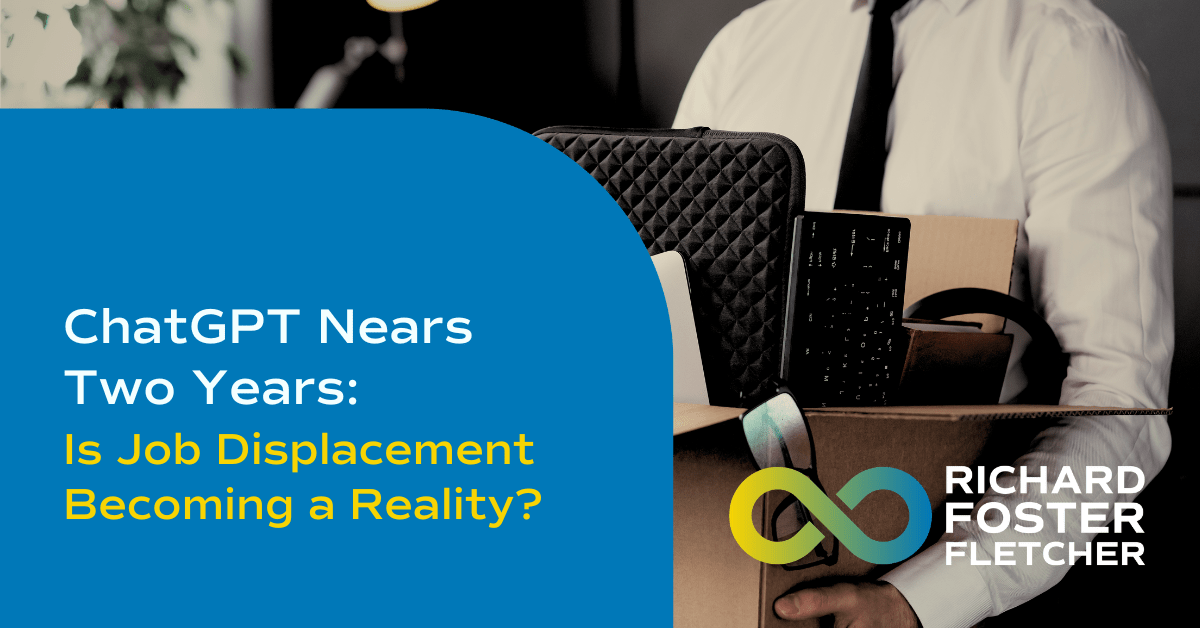
ChatGPT Nears Two Years: Is Job Displacement Becoming a Reality?

As we approach the two-year anniversary of ChatGPT 3.5’s release, it’s an opportune moment to reflect on its impact. ChatGPT, a revolutionary tool in artificial intelligence, has sparked widespread discussions and predictions about its potential effects on global employment. From its initial introduction, there was both excitement and trepidation about how AI could transform industries, streamline processes, and, inevitably, affect jobs. But two years in, how much of this has materialised?
The short answer is that two years is a brief period in the context of business and enterprise adoption. Large organisations, in particular, take significant time to integrate new technologies due to the complexities involved in change management, procurement processes, and the need to mitigate risks associated with innovative applications.
Early Adopters and Initial Impacts
Some early adopters have indeed made notable announcements. Klarna, a major player in the fintech industry, recently revealed job reductions as they integrated AI into their operations. This move reflects a broader trend where many CEOs are exploring AI’s potential for job displacement. However, it’s crucial to approach this issue with a nuanced perspective.
A valuable framework for understanding AI integration is the SAMR model: Substitute, Augment, Modify, and Replace. CEOs should evaluate each of these aspects rather than focusing solely on replacement:
- Substitute: Assess tasks that AI can perform as a direct substitute for human labour, allowing employees to focus on more complex activities.
- Augment: Identify areas where AI can enhance human capabilities, improving productivity and decision-making without displacing staff.
- Modify: Consider how AI can transform existing processes, making them more efficient or enabling new capabilities previously impossible.
- Replace: Carefully determine where AI can fully take over tasks, ensuring employees are transitioned smoothly to new roles or supported through reskilling initiatives.
The Freelance Market and SMEs
SMEs, which can pivot more swiftly than larger enterprises, have seen notable impacts. The freelance market, in particular, has experienced significant changes. Platforms like Fiverr, Freelancer.com, and Upwork report freelancers experiencing a reduced workload in fields such as translation, copywriting, research, design, and other creative services. This trend underscores the disruptive potential of AI in various sectors.
However, disruption doesn’t necessarily equate to decreased profitability. Duolingo’s experience with AI integration provides a compelling case study. Initially, Duolingo’s share price dropped with the release of ChatGPT, as investors feared competition from AI-driven language learning tools. Yet, Duolingo’s strategic responses and innovations have since led to a share price recovery.
Duolingo’s Strategic Response
A key factor in Duolingo’s rebound has been the broader rollout and enhancement of its “Max” subscription tier. By optimising their subscription offerings and improving the Family Plan, Duolingo has boosted user retention. Analysts have noted that these improvements made Duolingo’s subscription model more attractive and sustainable, providing a solid foundation for revenue growth.
Additionally, Duolingo has integrated AI-powered conversational experiences into its platform, allowing users to engage more interactively. These features, which include interactions with Duolingo characters, complement ChatGPT by offering a structured and playful learning environment aligned with Duolingo’s educational goals. This strategic use of AI has bolstered investor confidence, as the company effectively leverages AI to enhance its platform.
Internal Business Impacts
In my own business, we’ve witnessed a reduced need for roles in marketing, HR, research, design, and legal. In some cases, this has meant fewer team members; in others, we rely less on external consultants. Recently, we automated significant portions of our website, saving thousands of dollars we would have otherwise spent on external consultants, all for a mere $20 a month per ChatGPT license.
This scenario illustrates how AI is extracting value from traditional systems. By scaling up, one can envision the level of displacement possible, especially in larger companies. However, larger organisations cannot adopt AI as swiftly as smaller ones.
Misconceptions and Strategic Missteps
In recent discussions with CEOs, several misconceptions about AI have surfaced, leading to strategic missteps. One common misconception is the belief that AI can be implemented without first addressing their data issues. Witnessing the potential of generative AI platforms like ChatGPT at home, many CEOs rush to integrate similar technologies at work. However, leveraging AI effectively requires sorting out first-party and third-party data. Understanding data fundamentals is crucial before any meaningful AI implementation can occur.
Another misconception is that employees can be prevented from using ChatGPT. With multiple devices and remote working arrangements, it’s nearly impossible to stop them. ChatGPT is too valuable to ignore. Businesses should develop strategies that acknowledge and incorporate the inevitable use of these tools, ensuring that data shared into these models is managed securely and responsibly.
There’s a compelling argument for CEOs that employees will be more productive using generative AI through large language models. Hence, it’s vital to ensure that even basic LLMs are available to employees, where data can be managed and protected in-house. This approach helps level up the workforce’s capabilities, even if it doesn’t necessarily compete with major players like Microsoft, Google, and Amazon.
Using generative AI is a moving feast, evolving almost daily. It requires significant skill to get anything other than mediocre, biased, basic content from these applications. While much of the textual content produced is basic at best, those skilled in using these tools will thrive, widening the gap between them and those who can’t or won’t harness AI’s full potential.
The Long-Term Outlook
Finally, while predicting job impacts is highly speculative, assuming that AI will simply create more jobs is misguided. AI is more likely to create opportunities, which can be transformed into more companies and jobs with careful government intervention. Such intervention is necessary to ensure that more people can benefit from, leverage, and harness the power of AI to develop their ideas. Without this purposeful and strategic intervention, the benefits will primarily go to existing tech companies and a few well-timed entrepreneurs. This is not enough to counter the potential job displacement over the coming years. To me, this is urgent.
















